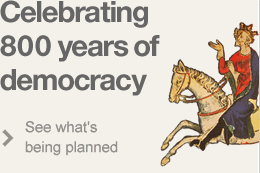Geoffrey de Mandeville, another of the east of England rebels, was the son and heir of Geoffrey FitzPeter, earl of Essex, long-serving justiciar to both Richard and John, by his first wife Beatrice, daughter of William de Say and eventual heiress of the Mandeville earls of Essex. By virtue of the family’s ancestral connection Beatrice’s children styled themselves Mandevilles.
Geoffrey’s first marriage was to Maud, daughter of Robert FitzWalter, another important Essex landowner and the man who was to be effective leader of the baronial rebellion against John. According to the Histoire des ducs de Normandie, Robert once sprang to the defence of his son-in-law when the latter killed a serving man in a dispute over lodgings at court and John threatened to hang him, declaring ‘By God’s body, you will not hang my son-in-law, you’ll see two hundred lanced knights in your land before you hang him!’ When the king put the case up for trial, FitzWalter appeared in court with two hundred knights.
Maud de Mandeville died without issue and was buried in Dunmow priory (Essex). In January 1214 Geoffrey took as his second wife Isabella, third daughter and coheiress of William, earl of Gloucester, and the divorced ex-wife of King John. The terms on which Geoffrey was to take Isabella were extraordinary. He was to pay the king a fine of 20,000 marks (about £13,666), the sum to be paid in four instalments each of 5,000 marks, the last to be handed over in Michaelmas 1214, with the proviso that the king might resume Isabella’s lands if the payments were to fall into arrears. These terms were nothing short of ruinous and quite impossible for the earl to meet. The first instalment was set to be paid before the king set sail to Poitou in February 1214. Needless to say, Geoffrey failed to meet the deadline, and the king accordingly ordered the sheriffs to put in hand measures for resumption. By August, however, Geoffrey was evidently beginning to give some satisfaction, and John ordered delivery to him of his wife’s honor of Gloucester, the heartland of the estates. After that, the whole matter was overtaken by events.
Why did Geoffrey submit to this Faustian financial bargain with the king? Certainly he was able to enjoy the revenues of Isabella’s substantial estates for as long as she lived, these amounting to roughly 800 marks a year. After his wife’s death, however, he would lose them, as her heirs were the de Clare earls of Hertford. Moreover, there was little prospect of him establishing a new lineage by her as she was well beyond child-bearing age.
The most likely explanation for Geoffrey’s submission is that the king held a pistol to his head by threatening to revive the de Say claim to his lands (for which, see the life of Geoffrey de Say). If this action had succeeded in the courts, the earl would have been left with nothing to his name. As it happened, Geoffrey gave in to the king, and the de Say claim was thrown out shortly after John set sail to Poitou.
In the light both of his grievances against John and of his family connections with Robert FitzWalter, it is not surprising to find Geoffrey on the rebel side in 1215. In June he was named to the Twenty-Five and, when the barons parcelled out the government of the country in the autumn, he was assigned responsibility for Essex.
Geoffrey met his death by accident in a tournament with a French knight in London in February 1216, and was buried in Holy Trinity priory, Aldgate.
By Professor Nigel Saul, Royal Holloway, University of London.
Featured Article
796 years ago tomorrow a reluctant, but resigned, and most definitely scheming King John was brought to Runnymede to put his seal to the Great Charter of Liberty – Magna Carta. John might have acceded to the Barons’ demands...
Read on...Recent Articles
- Magna Carta's American Adventure
- 800th anniversary of Bristol...
- Bristol 800 concert and...
- Emancipation and Magna Carta
- Terrorism and Tolerance -...
- Magna Carta
- Magna Carta Benches mark...
- ABA Magna Carta Memorial...
Stay updated
If you would like to keep informed about the work of the Magna Carta Trust and our partners, please sign up to the newsletter below.
Become a Supporter
There are a number of significant supporter opportunities. Register your interest early to ensure the widest range of options.
Find out more




